Pattern 1925 Blue-grey Web Equipment - Belts, Braces, and Straps
Strap, adjustment

 The Pattern 1925 Adjustment strap was introduced with the Web Equipment, R.A.F., Pattern 1925, under Air Ministry Weekly Order No. 793/1927, as Stores Ref. 23/85. The Adjustment strap is identical to the Naval W.E. Patt. '19 version, except for two spigot halves of a press fastener added to the lower left side. These provide additional adjustment for locating the Frog, which has the matching crown halves of the fastener. In the Rifle Equipment, the strap connects the two Cartridge carrier, left and -right together. It can also be used with two Side pieces replacing the Cartridge carriers to produce a stand-alone Waist belt. An example in this configuration is shown in the Pistol Equipment Section. This example is maker marked "M.E. Co." and is dated 1928. From the Karkee Web Collection.
The Pattern 1925 Adjustment strap was introduced with the Web Equipment, R.A.F., Pattern 1925, under Air Ministry Weekly Order No. 793/1927, as Stores Ref. 23/85. The Adjustment strap is identical to the Naval W.E. Patt. '19 version, except for two spigot halves of a press fastener added to the lower left side. These provide additional adjustment for locating the Frog, which has the matching crown halves of the fastener. In the Rifle Equipment, the strap connects the two Cartridge carrier, left and -right together. It can also be used with two Side pieces replacing the Cartridge carriers to produce a stand-alone Waist belt. An example in this configuration is shown in the Pistol Equipment Section. This example is maker marked "M.E. Co." and is dated 1928. From the Karkee Web Collection.
Braces
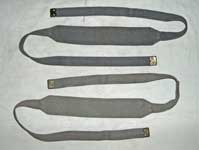
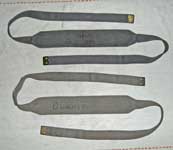 The Pattern 1925 Braces were introduced with the Web Equipment, R.A.F., Pattern 1925, under Air Ministry Weekly Order No. 783/1927, as Stores Ref. 23/75 (left) and 23/76 (right). The Braces are identical to the Patt. '19 and early Patt. '37 versions, i.e. they are reduction woven. The are 1-inch wide, with an approximately 18-inch section in the middle that widens to 2-inches. The left Brace has a crossover loop that the right Brace passes through, in order to prevent the Braces from "riding up" when being worn. Both of these Braces are stamped with the Crown over A.M. Air Ministry mark. The right Brace (above in the pictures) is maker coded "716101/37" and dated 1938. The left Brace is maker coded "3548/38"; it is also dated 1938. Both these codes are Contract numbers, for 1937 and 1938 respectively. British accoutrements were not marked with Stores Codes until 1945. From the Karkee Web Collection.
The Pattern 1925 Braces were introduced with the Web Equipment, R.A.F., Pattern 1925, under Air Ministry Weekly Order No. 783/1927, as Stores Ref. 23/75 (left) and 23/76 (right). The Braces are identical to the Patt. '19 and early Patt. '37 versions, i.e. they are reduction woven. The are 1-inch wide, with an approximately 18-inch section in the middle that widens to 2-inches. The left Brace has a crossover loop that the right Brace passes through, in order to prevent the Braces from "riding up" when being worn. Both of these Braces are stamped with the Crown over A.M. Air Ministry mark. The right Brace (above in the pictures) is maker coded "716101/37" and dated 1938. The left Brace is maker coded "3548/38"; it is also dated 1938. Both these codes are Contract numbers, for 1937 and 1938 respectively. British accoutrements were not marked with Stores Codes until 1945. From the Karkee Web Collection.
STRAP, supporting, rucksack
![]() The Pattern 1925 Strap, supporting, rucksack was not listed in A.M.W.O. 793/1927, being considered a part of the Rucksack. Recognising that it was loose, by January 1942, it was separately catalogued in Section 23 (Accoutrements) of Air Publication 1086 Priced Vocabulary of Royal Air Force Equipment. It is 3/4-inches wide and approximately 15-inches long, with a brass tip at one end and a flat brass hook at the other. When the Rucksack, top part, is used alone, this Strap connects to a buckle at the bottom of the Rucksack. The hook is inserted into the D-shaped loop at the side of the Haversack hook on the right-hand shoulder strap of the Rucksack, top part. The term Haversack hook is an Army one, as this piece-part was not itemised in R.A.F. stores listings. This enables the wearer to easily release the hook and swing the Rucksack, top part, off his shoulder when removing it. When both parts of the Rucksack are worn, the strap is moved to a buckle on the bottom of the Rucksack, bottom part. The way this strap connects to the rest of the equipment can be seen in the pictures in the Set Displays Section. Perhaps because it is small and easily lost, or for some other unknown reason, this Strap is almost always missing - to the extent that there has been serious discussion among collectors suggesting that it was never actually on general issue at all. To some degree, that may be understandable wishful thinking, but it's incorrect. The ease with which the Supporting strap could be lost seems to have recognized at some point. Rucksacks, top part, with a fixed Strap, as with Patt. ’37 Haversack straps, have been noted from a few manufacturers. Both variations of the Rucksack, top part, are shown in the Packs and Haversacks Section. As an aside, the Rucksack, top part, was nicknamed The Octopus by some airmen, with its Supporting strap called a Kicking Strap. A collector has noted this latter title – used officially – on a War Office photograph of a post-war trials Pattern. This example is not maker marked and is undated. From the Karkee Web Collection.
The Pattern 1925 Strap, supporting, rucksack was not listed in A.M.W.O. 793/1927, being considered a part of the Rucksack. Recognising that it was loose, by January 1942, it was separately catalogued in Section 23 (Accoutrements) of Air Publication 1086 Priced Vocabulary of Royal Air Force Equipment. It is 3/4-inches wide and approximately 15-inches long, with a brass tip at one end and a flat brass hook at the other. When the Rucksack, top part, is used alone, this Strap connects to a buckle at the bottom of the Rucksack. The hook is inserted into the D-shaped loop at the side of the Haversack hook on the right-hand shoulder strap of the Rucksack, top part. The term Haversack hook is an Army one, as this piece-part was not itemised in R.A.F. stores listings. This enables the wearer to easily release the hook and swing the Rucksack, top part, off his shoulder when removing it. When both parts of the Rucksack are worn, the strap is moved to a buckle on the bottom of the Rucksack, bottom part. The way this strap connects to the rest of the equipment can be seen in the pictures in the Set Displays Section. Perhaps because it is small and easily lost, or for some other unknown reason, this Strap is almost always missing - to the extent that there has been serious discussion among collectors suggesting that it was never actually on general issue at all. To some degree, that may be understandable wishful thinking, but it's incorrect. The ease with which the Supporting strap could be lost seems to have recognized at some point. Rucksacks, top part, with a fixed Strap, as with Patt. ’37 Haversack straps, have been noted from a few manufacturers. Both variations of the Rucksack, top part, are shown in the Packs and Haversacks Section. As an aside, the Rucksack, top part, was nicknamed The Octopus by some airmen, with its Supporting strap called a Kicking Strap. A collector has noted this latter title – used officially – on a War Office photograph of a post-war trials Pattern. This example is not maker marked and is undated. From the Karkee Web Collection.
 Another example of the Kicking strap. This one has a contract stamp of 108970/40, and is dated 1940. From the Steve Hewitt Collection, photo © Steve Hewitt 2009.
Another example of the Kicking strap. This one has a contract stamp of 108970/40, and is dated 1940. From the Steve Hewitt Collection, photo © Steve Hewitt 2009.
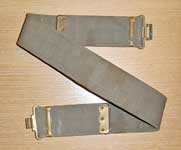
 The Pattern 1925 Belt, waist, adjustable was introduced with the Web Equipment, R.A.F., Pattern 1925, under Air Ministry Weekly Order No. 793/1927, as Stores Ref. 23/74. Within the British Armed Forces this was the first authorisation of such an item. Previous field equipments from Knapsack Equipment, through Valise Equipment, to Bandolier Equipment and Patt.’08 W.E. all had separate Waistbelts.
The Pattern 1925 Belt, waist, adjustable was introduced with the Web Equipment, R.A.F., Pattern 1925, under Air Ministry Weekly Order No. 793/1927, as Stores Ref. 23/74. Within the British Armed Forces this was the first authorisation of such an item. Previous field equipments from Knapsack Equipment, through Valise Equipment, to Bandolier Equipment and Patt.’08 W.E. all had separate Waistbelts.
In Drill Order, it was often preferable to have a Belt and Bayonet frog alone. In addition, when British soldiers were Walking Out, i.e. off camp and in public, Belts and bayonets were always worn and a “swagger stick” was usually carried, so that hands were not idle! Patt. ’13 W.E. was a Back-Adjustment pattern, the “belt”, such as it was, comprised an unsuitable three elements. The Canadian Army were therefore the first to add a requirement for a proper Belt, in their case termed a Belt, walking-out.
When the R.A.F. adopted Patt. ’25, another Back-Adjustment pattern, the same problem existed – no proper Belt for drill and ceremonial. The Patt. ’13 Belt was a simple length of strapping, with a 2-inch Twigg buckle, whereas the R.A.F. solution was more complicated. It was made from Mills’ patented “flat-loop belting”, thereby adjusting at the front with turn-backs. This was not new, having first been used on the belts of Mills’ Cavalry Trials patterns of 1912 and 1913. Unlike the Patt. ’37 W.E. Belt, adopted 17 years later by the R.A.F., the Patt. ’25 Belt had no back buckles.
In 1941, blue-grey Patt. ’37 was approved for the R.A.F.. Many components were interchangeable with Patt. ’25, such that the R.A.F. then blurred the distinction by combining both patterns as Equipment, web, blue-grey, R.A.F. Pattern, under which the belt nomenclature was changed to Belt, waist, ceremonial, adjustable. Back buckles were added to the Patt. ’25 belts, converting them to Patt. ’37. Manufacture of most Patt. ’25 items ceased after 1941, so the old Patt. ’25 format was achieved by removing the back buckles from Patt. ’37 Belts.
This example has no maker’s name, but is marked with a Contract Number, "716101/37”, the date “1938” and the usual Crowned A.M. ownership mark. This Belt is from the Collection of Roger Dennis. Phot0 © Roger Dennis 2008.
SLING, rifle, web, R.A.F. Pattern 1925
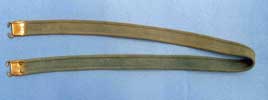 This sling was introduced with the Web Equipment, R.A.F., Pattern 1925, under Air Ministry Weekly Order No. 793/1927, as Stores Ref. 23/88, a matching sling obviously being required. Coded 23/88, its nomenclature was simply coincident as to the Pattern Year. However, by 1942, the R.A.F. had included it as EQUIPMENT, web, blue-grey, R.A.F. Pattern, 1925, Sling, rifle. As such, it was one of only four military slings to be designated part of a pattern of accoutrements. Only one, the leather Sling, rifle, Pattern, 1914 was an Army item, the others were all R.A.F.:
This sling was introduced with the Web Equipment, R.A.F., Pattern 1925, under Air Ministry Weekly Order No. 793/1927, as Stores Ref. 23/88, a matching sling obviously being required. Coded 23/88, its nomenclature was simply coincident as to the Pattern Year. However, by 1942, the R.A.F. had included it as EQUIPMENT, web, blue-grey, R.A.F. Pattern, 1925, Sling, rifle. As such, it was one of only four military slings to be designated part of a pattern of accoutrements. Only one, the leather Sling, rifle, Pattern, 1914 was an Army item, the others were all R.A.F.:
| 23/88 EQUIPMENT | web, blue-grey, R.A.F. Pattern, 1937 | As no new sling was required, it simply stated “See Ref. No. 88” |
| 23/6 EQUIPMENT | web, drab, 1908 Pattern, Sling, rifle | |
| 23/216 EQUIPMENT | web, drab, 1937 Pattern, Sling, rifle | This was an un-necessary code as, fairly obviously, except to the R.A.F., this was 23/6. By 1958, only the 23/216 code was listed and with its Pattern 1937 title |
This example is from the Ed Storey Collection. Photo © Ed Storey 2008.
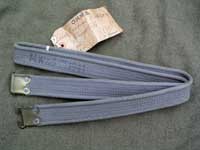
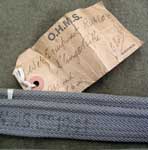 Another interesting example, this one a Working Pattern. Maker marked "M.W. & S. Ltd." and dated 1941. Photos courtesy of Paul Laidlaw at War Department Militaria.
Another interesting example, this one a Working Pattern. Maker marked "M.W. & S. Ltd." and dated 1941. Photos courtesy of Paul Laidlaw at War Department Militaria.